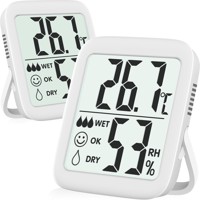This is part of our main guide The big Dehumidifier Test 2025
Why keep an eye on humidity?
Indoor humidity describes how much water vapor is present in the air. In rooms it can change quickly — for example when cooking, showering, or drying laundry. High values can be uncomfortable and cause long-term damage.
Signs of a moist indoor climate include fogged windows, damp spots on walls, or a musty smell. A simple tool is a hygrometer, which measures humidity. Check the device manual or manufacturer specs for guidance.
What is humidity?
Humidity is the amount of water vapor in the air. Depending on temperature, air can hold more or less moisture. Warm air holds more moisture, cold air less. That’s why condensation often forms on cold surfaces like windows or exterior walls.
How do I recognize excessive humidity?
- Fogged glass, especially in the morning.
- Damp spots on walls or in corners.
- A sweet, musty smell in the room.
- Textiles feel clammy.
If you notice these signs, act to prevent damage or mold growth. The German Environment Agency offers more background information.
Immediate measures without technology
You can already lower indoor humidity with small changes. These measures are instantly implementable without buying devices.
- Ventilate properly: Open windows several times a day for short, strong airing instead of keeping them tilted.
- Reduce steam: Use lids when cooking, keep bathroom doors closed during showering, and switch on extractor fans.
- Drying laundry: Dry outside or in well-ventilated rooms. Alternatively, dry in a room with an open window.
- Heating: Keep rooms heated evenly to avoid temperature differences and moisture pockets.
How to ventilate correctly
For burst ventilation, open opposite windows wide to create a cross-flow that carries moist air outside. The duration depends on the season — in winter shorter times are enough because of the larger temperature difference.
Controlling laundry and cooking steam
Avoid placing multiple drying racks in small rooms. When cooking, open a window or run the hood. Close the kitchen door so steam doesn’t spread.
Three simple home remedies and how to use them
Home remedies are a quick, cheap solution for mildly damp rooms. They can absorb moisture but have limits.
Using salt: how to do it
Salt is hygroscopic — it attracts moisture from the air.
Usage tips:
- Place a bowl with coarse salt in the room.
- Use a large surface area for better effect.
- Check regularly whether the salt feels clumpy.
- Replace as needed.
Rice and cat litter: usage & limits
Rice works similarly to salt by binding moisture. Use large containers so the rice has good air contact. It’s ideal for small cupboards or cellar nooks. Mineral-based cat litter also absorbs moisture. Place it in open bowls and check regularly. Make sure children or pets cannot reach it.
Limits: Home remedies only suit mild problems. For persistent high humidity or visible mold, they are insufficient.
Plants, furniture and room layout
Furniture and decor also affect the room climate. Small adjustments often make a big difference.
Which houseplants to choose?

Many plants transpire and increase indoor humidity. If you have humidity issues, prefer species with low water needs. Examples:
- Cacti
- Snake plant (Sansevieria)
- Aloe Vera
These are low-maintenance and release little moisture into the air.
Furniture placement and textiles
- Don’t place furniture directly against cold exterior walls.
- Leave a small gap so air can circulate.
- Thick rugs or heavy curtains can store moisture — reduce these if necessary.
Checklist for room layout:
- Keep furniture slightly away from walls.
- Limit textiles in humid rooms.
- Don’t block air circulation.
Monitoring, mold prevention and when to use technology
Regular monitoring protects best against damage. Use a hygrometer to check humidity and see whether measures work.

- Accurate measurement: ±1°C temperature, ±5% humidity
- Large LCD display for easy reading
- 2-pack with magnet & stand - flexible placement
How to use a hygrometer correctly
- Place the device centrally in the room, not directly on windows or radiators.
- Read and document the values regularly.
- Don’t state a strict target range — recommendations vary by source.
When a dehumidifier or professional is necessary
If humidity stays high despite home remedies or mold appears, ventilation alone won’t suffice. Then a technical dehumidifier is a sensible solution. For large-scale mold, always hire professionals. The Consumer Advice Center recommends acting early to prevent building and health damage.
FAQ
Which home remedies actually help against humidity?
Salt, rice and cat litter can be placed in bowls to absorb moisture. They help with mild dampness. For serious problems, technical devices or professional help are required.
How do I ventilate correctly to reduce humidity?
Burst ventilation means opening windows fully to create cross-ventilation. Do this several times a day and adapt duration to the season.
When are home remedies not enough?
When walls stay damp for long, windows are constantly fogged or mold is visible. Then dehumidifiers or professional services are necessary.
Do houseplants make humidity worse?
Some plants increase humidity significantly. If you have issues, choose species like cacti or snake plant that release little moisture.
